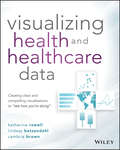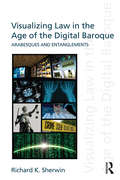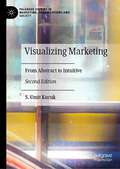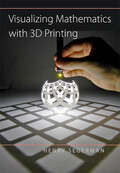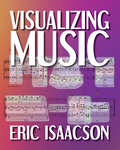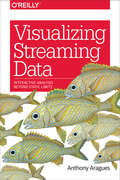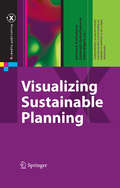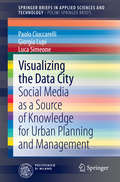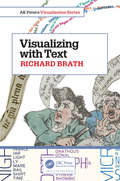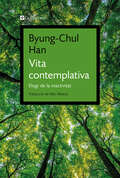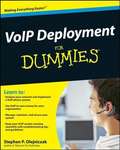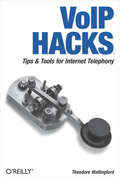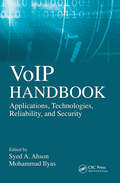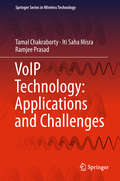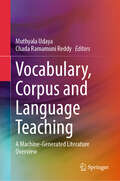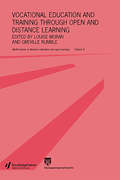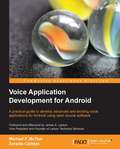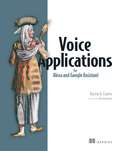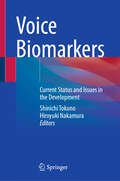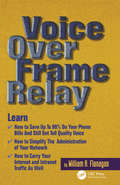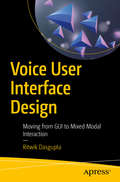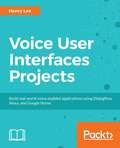- Table View
- List View
Visualizing Health and Healthcare Data: Creating Clear and Compelling Visualizations to "See How You're Doing"
by Katherine Rowell Lindsay Betzendahl Cambria BrownThe only data visualization book written by and for health and healthcare professionals. In health and healthcare, data and information are coming at organizations faster than they can consume and interpret it. Health providers, payers, public health departments, researchers, and health information technology groups know the ability to analyze and communicate this vast array of data in a clear and compelling manner is paramount to success. However, they simply cannot find experienced people with the necessary qualifications. The quickest (and often the only) route to meeting this challenge is to hire smart people and train them. Visualizing Health and Healthcare Data: Creating Clear and Compelling Visualizations to "See how You're Doing" is a one-of-a-kind book for health and healthcare professionals to learn the best practices of data visualization specific to their field. It provides a high-level summary of health and healthcare data, an overview of relevant visual intelligence research, strategies and techniques to gather requirements, and how to build strong teams with the expertise required to create dashboards and reports that people love to use. Clear and detailed explanations of data visualization best practices will help you understand the how and the why. Learn how to build beautiful and useful data products that deliver powerful insights for the end user Follow along with examples of data visualization best practices, including table and graph design for health and healthcare data Learn the difference between dashboards, reports, multidimensional exploratory displays and infographics (and why it matters) Avoid common mistakes in data visualization by learning why they do not work and better ways to display the data Written by a top leader in the field of health and healthcare data visualization, this book is an excellent resource for top management in healthcare, as well as entry-level to experienced data analysts in any health-related organization.
Visualizing Law in the Age of the Digital Baroque: Arabesques & Entanglements
by Richard K SherwinVisualizing Law in the Age of the Digital Baroque explores the profound impact that visual digital technologies are having on the practice and theory of law. Today, lawyers, judges, and lay jurors face a vast array of visual evidence and visual argument. From videos documenting crimes and accidents to computer displays of their digital simulation, increasingly, the search for fact-based justice inside the courtroom is becoming an offshoot of visual meaning making. But when law migrates to the screen it lives there as other images do, motivating belief and judgment on the basis of visual delight and unconscious fantasies and desires as well as actualities. Law as image also shares broader cultural anxieties concerning not only the truth of the image but also the mimetic capacity itself, the human ability to represent reality. What is real, and what is simulation? This is the hallmark of the baroque, when dreams fold into dreams, like immersion in a seemingly endless matrix of digital appearances. When fact-based justice recedes, laws proliferate within a field of uncertainty. Left unchecked, this condition of ontological and ethical uneasiness threatens the legitimacy of law’s claim to power. Visualizing Law in the Age of the Digital Baroque offers a jurisprudential paradigm that is equal to the challenge that current cultural conditions present.
Visualizing Marketing: From Abstract to Intuitive (Palgrave Studies in Marketing, Organizations and Society)
by S. Umit KucukThis book focuses on marketing graphics, figures, and visual artifacts discussed in marketing theory in order to explain and discuss marketing concepts visually, and open a door to future predictions of the evolution of such marketing concepts. Marketing concepts are, by nature, abstract and there is a need for approaches that provide a clear picture of such concepts, along with concrete and hands-on knowledge tools to students, scholars, and practitioners. Furthermore, the recent rising importance and popularity of digital marketing tools and marketing metrics make visualization of such important marketing phenomena possible. Visualizing or concretizing of marketing data is more important than ever as the usage and presentation of such enormous amounts of data requires visual representation. Whereas the first edition focused on traditional marketing elements, namely the 4Ps or marketing mix elements, this edition includes a new section focusing on digital marketing, which introduces the 4Cs, defined as Connectivity, Content, Community and Commitment. Consequently, this edition provides a broader view of marketing concepts by also proposing a new conceptualization to today’s dynamically changing digital marketing value creation tools. As a result, this book develops a new foundation of digital marketing and provides an alternative way of discussing and explaining marketing concepts, old and new, with visual representations.
Visualizing Mathematics with 3D Printing
by Henry SegermanThe first book to explain mathematics using 3D printed models.Winner of the Technical Text of the Washington PublishersWouldn’t it be great to experience three-dimensional ideas in three dimensions? In this book—the first of its kind—mathematician and mathematical artist Henry Segerman takes readers on a fascinating tour of two-, three-, and four-dimensional mathematics, exploring Euclidean and non-Euclidean geometries, symmetry, knots, tilings, and soap films. Visualizing Mathematics with 3D Printing includes more than 100 color photographs of 3D printed models. Readers can take the book’s insights to a new level by visiting its sister website, 3dprintmath.com, which features virtual three-dimensional versions of the models for readers to explore. These models can also be ordered online or downloaded to print on a 3D printer. Combining the strengths of book and website, this volume pulls higher geometry and topology out of the realm of the abstract and puts it into the hands of anyone fascinated by mathematical relationships of shape. With the book in one hand and a 3D printed model in the other, readers can find deeper meaning while holding a hyperbolic honeycomb, touching the twists of a torus knot, or caressing the curves of a Klein quartic.
Visualizing Music
by Eric IsaacsonTo feel the emotional force of music, we experience it aurally. But how can we convey musical understanding visually?Visualizing Music explores the art of communicating about music through images. Drawing on principles from the fields of vision science and information visualization, Eric Isaacson describes how graphical images can help us understand music. By explaining the history of music visualizations through the lens of human perception and cognition, Isaacson offers a guide to understanding what makes musical images effective or ineffective and provides readers with extensive principles and strategies to create excellent images of their own. Illustrated with over 300 diagrams from both historical and modern sources, including examples and theories from Western art music, world music, and jazz, folk, and popular music, Visualizing Music explores the decisions made around image creation. Together with an extensive online supplement and dozens of redrawings that show the impact of effective techniques, Visualizing Music is a captivating guide to thinking differently about design that will help music scholars better understand the power of musical images, thereby shifting the ephemeral to material.
Visualizing Streaming Data: Interactive Analysis Beyond Static Limits
by Anthony AraguesWhile tools for analyzing streaming and real-time data are gaining adoption, the ability to visualize these data types has yet to catch up. Dashboards are good at conveying daily or weekly data trends at a glance, though capturing snapshots when data is transforming from moment to moment is more difficult—but not impossible.With this practical guide, application designers, data scientists, and system administrators will explore ways to create visualizations that bring context and a sense of time to streaming text data. Author Anthony Aragues guides you through the concepts and tools you need to build visualizations for analyzing data as it arrives.Determine your company’s goals for visualizing streaming dataIdentify key data sources and learn how to stream themLearn practical methods for processing streaming dataBuild a client application for interacting with events, logs, and recordsExplore common components for visualizing streaming dataConsider analysis concepts for developing your visualizationDefine the dashboard’s layout, flow direction, and component movementImprove visualization quality and productivity through collaborationExplore use cases including security, IoT devices, and application data
Visualizing Sustainable Planning
by Hans Hagen Subhrajit Guhathakurta Gerhard SteinebachThe authors present the state of the art in the rapidly growing field of visualization as related to problems in urban and regional planning. The significance and timeliness of this volume consist in its reflection of several developments in literature and the challenges cities are facing. First, the unsustainability of many of our current paradigms of development has become evidently clear. We are entering an era in which communities across the globe are strengthening their connections to the global flows of capital, goods, ideas, technologies and values while facing at the same time serious dislocations in their traditional socioeconomic structures. While the impending scenarios of climate change impacts remind us about the integrated ecological system that we are part of, the current discussions about global recession in the media alert us and make us aware of the occasional perils of the globalized economic system. The globally dispersed, intricately integrated and hyper-complex socioeconomic-ecological system is difficult to analyze, comprehend and communicate without effective visualization tools. Given that planners are at the frontlines in the effort to prepare as well as build resilience in the impacted communities, appropriate visualization tools are indispensable for effective planning. Second, planners have largely been slow to incorporate the advances in visualization research emerging from other domains of inquiry.
Visualizing the Data City
by Giorgia Lupi Paolo Ciuccarelli Luca SimeoneThis book investigates novel methods and technologies for the collection, analysis and representation of real-time user-generated data at the urban scale in order to explore potential scenarios for more participatory design, planning and management processes. For this purpose, the authors present a set of experiments conducted in collaboration with urban stakeholders at various levels (including citizens, city administrators, urban planners, local industries and NGOs) in Milan and New York in 2012. It is examined whether geo-tagged and user-generated content can be of value in the creation of meaningful, real-time indicators of urban quality, as it is perceived and communicated by the citizens. The meanings that people attach to places are also explored to discover what such an urban semantic layer looks like and how it unfolds over time. As a conclusion, recommendations are proposed for the exploitation of user-generated content in order to answer hitherto unsolved urban questions. Readers will find in this book a fascinating exploration of techniques for mining the social web that can be applied to procure user-generated content as a means of investigating urban dynamics.
Visualizing with Text (AK Peters Visualization Series)
by Richard BrathVisualizing with Text uncovers the rich palette of text elements usable in visualizations from simple labels through to documents. Using a multidisciplinary research effort spanning across fields including visualization, typography, and cartography, it builds a solid foundation for the design space of text in visualization. The book illustrates many new kinds of visualizations, including microtext lines, skim formatting, and typographic sets that solve some of the shortcomings of well-known visualization techniques. Key features: More than 240 illustrations to aid inspiration of new visualizations Eight new approaches to data visualization leveraging text Quick reference guide for visualization with text Builds a solid foundation extending current visualization theory Bridges between visualization, typography, text analytics, and natural language processing Designers, developers, and academics can use this book as a reference and inspiration for new approaches to visualization in any application that uses text.
Vita contemplativa: Elogi de la inactivitat
by Byung-Chul HanUna poderosa crida a abandonar la vida hiperactiva per recuperar l'equilibri i la riquesa interior. Estem perdent la nostra capacitat de no fer res. La nostra existència és absorbida per l'activitat i, per tant, completament explotada. Atès que només percebem la vida en termes de rendiment, tendim a entendre la inactivitat com un dèficit, una negació o una absència d'activitat quan es tracta, ben al contrari, d'una interessant capacitat independent. Byung-Chul Han indaga en els beneficis, l'esplendor i la màgia de l'ociositat i dissenya una nova forma de vida que inclogui moments contemplatius amb els quals poder afrontar la crisi actual de la nostra societat i frenar la nostra pròpia explotació i la destrucció de la naturalesa.
Vivir en la nube: Adolescencia en tiempos digitales
by Roberto BalaguerRoberto Balaguer nos presenta de manera clara y concisa las problemáticas que surgen en el convulsionado mundo de internet. Ya hemos aceptado que la tecnología está cambiando al mundo de forma acelerada. Como padres, como docentes, e incluso como usuarios, intentamos enfrentar nuestros temores y acompañar a aquellos para quienes somos un referente. Sin embargo, no siempre lo logramos. A través de las páginas de este libro, Roberto Balaguer nos presenta de manera clara y concisa las problemáticas que surgen en este mundo. Además de darnos herramientas para comprender como pararnos en este escenario, nos invita a cuestionar nuestras respuestas políticamente correctas y a reflexionar sobre nuestras decisiones de la vida cotidiana. Cuando la sociedad se conmovió por la aparición del juego en línea llamado Ballena azul, el autor nos planteaba: Inmersos en una cultura de saturación de información, de alta tecnología, es frecuente que ante todos estos cambios busquemos hacer frente a los desafíos que tenemos como padres con más tecnología, pero lo cierto es que eso no siempre funciona. En toda esta temática hay tres palabras, que casualmente empiezan de la misma manera, «con», y que ilustran distintos modos de abordar estas cuestiones: control, confianza, contención.
VoIP Deployment For Dummies
by Stephen P. OlejniczakSo you're in charge of implementing a VoIP phone system for your organization? VoIP Deployment For Dummies is a crash course in Voice over Internet Protocol implementation!Here's how to analyze your network and implement a VoIP phone system, manage and maintain it, keep it secure, and troubleshoot problems. You'll learn how to plan the rollout, work with Session Initiation Protocol (SIP), handle fax issues, and keep your users happy.Understand how VoIP works, common misconceptions about it, and the pros and cons for your organizationCompare and comprehend hardware and software choicesDiscover the options for touch tones and faxing via VoIP systemsAnalyze network devices, IP addresses, connections to remote sites, and other aspects that will affect VoIP implementationDraw up a test plan, check out both voice and fax transmission, get a report, and schedule the installationInvestigate SIP call generation, identify the elements, understand cancelled calls, and re-INVITE callsTroubleshoot your system, identify call variables, trace the source of a problem, manage trouble tickets, and resolve failuresManage latency, jitter, and flap, and take advantage of WiresharkFind out what to expect when your system goes liveWritten by an expert with extensive real-world experience in VoIP implementation and management, VoIP Deployment For Dummies provides the know-how you need. You'll be able to implement your system and manage any issues proactively, which is sure to look good to your boss!
VoIP Hacks: Tips & Tools for Internet Telephony
by Theodore WallingfordVoice over Internet Protocol (VoIP) is gaining a lot of attention these days, as more companies and individuals switch from standard telephone service to phone service via the Internet. The reason is simple: A single network to carry voice and data is easier to scale, maintain, and administer. As an added bonus, it's also cheaper, because VoIP is free of the endless government regulations and tariffs imposed upon phone companies.VoIP is simply overflowing with hack potential, and VoIP Hacks is the practical guide from O'Reilly that presents these possibilities to you. It provides dozens of hands-on projects for building a VoIP network, showing you how to tweak and customize a multitude of exciting things to get the job done. Along the way, you'll also learn which standards and practices work best for your particular environment. Among the quick and clever solutions showcased in the book are those for:gauging VoIP readiness on an enterprise networkusing SIP, H.323, and other signaling specificationsproviding low-layer security in a VoIP environmentemploying IP hardphones, analog telephone adapters, and softPBX serversdealing with and avoiding the most common VoIP deployment mistakesIn reality, VoIP Hacks contains only a small subset of VoIP knowledge-enough to serve as an introduction to the world of VoIP and teach you how to use it to save money, be more productive, or just impress your friends. If you love to tinker and optimize, this is the one technology, and the one book, you must investigate.
VoIP Handbook: Applications, Technologies, Reliability, and Security
by Mohammad Ilyas Syed A. AhsonThe number of worldwide VoIP customers is well over 38 million. Thanks to the popularity of inexpensive, high-quality services, it's projected to increase to nearly 250 million within the next three years. The VoIP Handbook: Applications, Technologies, Reliability, and Security captures the state of the art in VoIP technology and serves as the comprehensive reference on this soon-to-be ubiquitous technology. It provides: A step-by-step methodology to evaluate VoIP performance prior to network implementation An invaluable overview of implementation challenges and several VoIP multipoint conference systems Unparalleled coverage of design and engineering issues such VoIP traffic, QoS requirements, and VoIP flow As this promising technology’s popularity increases, new demands for improved quality, reduced cost, and seamless operation will continue to increase. Edited by preeminent wireless communications experts Ahson and Illyas, the VoIP Handbook guides you to successful deployment.
VoIP Technology: Applications and Challenges (Springer Series in Wireless Technology)
by Ramjee Prasad Tamal Chakraborty Iti Saha MisraThis book offers an accessible introduction and practical guide to Voice over Internet Protocol (VoIP) technology, providing readers with the know-how to solve the problems encountered in applying VoIP technology across all types of network. It incorporates the latest research findings and brings readers up to date with the challenges that are faced by researchers developing novel applications of VoIP.The authors discuss the general architecture of VoIP technology, along with its application and relevance in conventional and emerging wireless communication networks, including Wireless Local Area Networks (WLANs), Worldwide Interoperability for Microwave Access (WiMAX), Long Term Evolution (LTE) and Cognitive Radio Networks. The book also includes Quality of service (QoS) studies under dynamic and unpredictable network conditions, which examine the reliability of both legacy systems And the upcoming pervasive computing systems. Further, it explains how the heuristic-based learning algorithms that are used in VoIP communications may help develop today’s technology in the area of autonomous systems.This book is a valuable source of information for academics and researchers, as it provides state-of-theart research in VoIP technology. It is also of interest to network designers, application architects, and service providers looking for a coherent understanding of VoIP across a wide range of devices, network applications and user categories.
Vocabulary, Corpus and Language Teaching: A Machine-Generated Literature Overview
by Muthyala Udaya Chada Ramamuni ReddyThis book is the result of a collaboration between a human editor and an artificial intelligence algorithm to create a machine-generated literature overview of research articles analyzing the importance of ESL/EFL vocabulary and corpus studies. It is a new publication format in which state-of-the-art computer algorithms are applied to select the most relevant articles published in Springer Nature journals and create machine-generated literature reviews by arranging the selected articles in a topical order and creating short summaries of these articles.This comprehensive book explores ESL/EFL vocabulary and corpus studies from five main perspectives: acquisition, strategies, ICT, corpus, and current practices. The sections delve into topics such as the impact of technology on learning, the power of corpora in language education, and innovative vocabulary-development techniques.This book is an essential resource for researchers, educators, and language facilitators seeking a deeper understanding of vocabulary within ESL/EFL teaching and learning contexts.
Vocational Education and Training in ASEAN Member States: Current Status and Future Development (Perspectives on Rethinking and Reforming Education)
by Bin Bai ParyonoThis book is the first monograph to systematically introduce readers to technology and vocational education and training in ASEAN countries. It details the current state of development and key development trends regarding technology and vocational education and training in the ten ASEAN countries. For each ASEAN country, the book addresses the history, status quo, characteristics, reform and development trends in technology and vocational education and training.The content mainly focuses on technology and vocational education and training systems, vocational qualification frameworks, technology and vocational education and training related personnel, etc. All the latest data presented here is drawn from the newest official website and research reports, accurately reflecting the development status of ASEAN countries and helping us make better forecasts regarding its future.This book offers a valuable reference guide for academic research in technology and vocational education and training. It can also be used as a textbook for postgraduate courses in technology and vocational education and training, as well as training material for various vocational education teachers and managers.
Vocational Education and Training through Open and Distance Learning: World review of distance education and open learning Volume 5
by Louise Moran Greville RumbleConventional apprenticeships and older methods of professional training are not providing enough skilled workers - governments, companies and colleges are now using open and distance learning to fill these gaps. Published in association with the Commonwealth of Learning, this unique review provides detailed analysis of worldwide experiences of vocational training and distance education. It looks at recent policy and practice at different levels - from transnational programmes and national policies to institutional and programme models. Offering guidance on how distance education and new technologies are being used to support vocational education and training, this book will help senior institutional managers and policy makers to understand and appreciate: * the role distance education can play in increasing skills levels in young people and the existing workforce* the challenges in using educational technologies, and distance education to deliver vocational education and training* how to devise effective policies to meet these challenges.
Vocational Education in the Fourth Industrial Revolution: Education and Employment in a Post-Work Age
by James AvisThis book examines the concept of the fourth industrial revolution and its potential impact on vocational education and training. Broadly located in a framework rooted in critical/radical theory, the book argues that the affordance of technologies surrounding the fourth industrial revolution are constrained by their location within a neoliberal, if not capitalist, logic. Thus, the impact of this revolution will be experienced differently across European regions as well as low and middle income economies. In order to break this impasse, this book calls for a politics based on non-reformist reforms, premised on an aspiration towards a socially just society that transcends capitalism.
Voice Application Development for Android
by Zoraida Callejas Michael F. MctearThis book will give beginners an introduction to building voice-based applications on Android. It will begin by covering the basic concepts and will build up to creating a voice-based personal assistant. By the end of this book, you should be in a position to create your own voice-based applications on Android from scratch in next to no time.Voice Application Development for Android is for all those who are interested in speech technology and for those who, as owners of Android devices, are keen to experiment with developing voice apps for their devices. It will also be useful as a starting point for professionals who are experienced in Android application development but who are not familiar with speech technologies and the development of voice user interfaces. Some background in programming in general, particularly in Java, is assumed.
Voice Applications for Alexa and Google Assistant
by Dustin CoatesSummaryVoice Applications for Alexa and Google Assistant is your guide to designing, building, and implementing voice-based applications for Alexa and Google Assistant. Inside, you'll learn how to build your own "skills"—the voice app term for actions the device can perform—from scratch.Foreword by Max Amordeluso.Purchase of the print book includes a free eBook in PDF, Kindle, and ePub formats from Manning Publications. You'll find registration instructions inside the print book.About the TechnologyIn 2018, an estimated 100 million voice-controlled devices were installed in homes worldwide, and the apps that control them, like Amazon Alexa and Google Assistant, are getting more powerful, with new skills being added every day. Great voice apps improve how users interact with the web, whether they're checking the weather, asking for sports scores, or playing a game.About the BookVoice Applications for Alexa and Google Assistant is your guide to designing, building, and implementing voice-based applications for Alexa and Google Assistant. You'll learn to build applications that listen to users, store information, and rely on user context, as you create a voice-powered sleep tracker from scratch. With the basics mastered, you'll dig deeper into multiuse conversational flow and other more-advanced concepts. Smaller projects along the way reinforce your new techniques and best practices. What's insideBuilding a call-and-response skillDesigning a voice user interfaceUsing conversational contextGoing multimodalTips and best practicesAbout the ReaderPerfect for developers with intermediate JavaScript skills and basic Node.js skills. No previous experience with voice-first platforms is required.About the AuthorDustin A. Coates is a developer who focuses on voice and conversational applications. He's currently the voice search lead at Algolia and is also a Google Developers Expert for Assistant as well as cohost of the VUX World podcast.Table of ContentsIntroduction to voice first Building a call-and-response skill on Alexa Designing a voice user interface Using entity resolution and built?in intents in Alexa skills Making a conversational Alexa skill VUI and conversation best practices Using conversation tools to add meaning and usabilityDirecting conversation flowBuilding for Google Assistant Going multimodal Push interactions Building for actions on Google with the Actions SDK
Voice Biomarkers: Current Status and Issues in the Development
by Hiroyuki Nakamura Shinichi TokunoThis book presents the latest research on speech biomarkers and demonstrates the benefits of quantitative measurement technology for emotion and stress in clinical settings. It begins with an introduction and details the validation of a technique for assessing emotions using voice biomarkers. This technology evaluates stress levels, which affect emotional expression and lead to changes in certain voice qualities. It further explains how a voice emotion recognition system can effectively detect illnesses such as anxiety disorders, depression, bipolar disorder, PTSD, Parkinson’s disease, dementia, and more. Beyond clinical applications, it is also useful for the mental care of athletes and assessing driving skills. Voice biomarkers can be easily, non-invasively, and remotely measured, offering excellent cost efficiency. This book lays the groundwork for addressing unresolved issues and advancing further. "Voice Biomarkers - Current Status and Issues in the Development" is an invaluable resource for healthcare professionals at all levels, especially those involved in pathophysiology, disaster psychology, mental health, and social medicine. Researchers in engineering will also find this book insightful.
Voice Over Frame Relay
by William FlanaganVoice Over Frame Relay - the next practical way to reduce your network costs! Savings from putting voice tie lines on frame relay data networks can pay back the additional investment in voice equipment in just months. Savings on international circuits are large enough to threaten present tariff structures (with some help from the FCC). From being '
Voice User Interface Design: Moving From Gui To Mixed Modal Interaction
by Ritwik DasguptaDesign and implement voice user interfaces. This guide to VUI helps you make decisions as you deal with the challenges of moving from a GUI world to mixed-modal interactions with GUI and VUI. The way we interact with devices is changing rapidly and this book gives you a close view across major companies via real-world applications and case studies.Voice User Interface Design provides an explanation of the principles of VUI design. The book covers the design phase, with clear explanations and demonstrations of each design principle through examples of multi-modal interactions (GUI plus VUI) and how they differ from pure VUI. The book also differentiates principles of VUI related to chat-based bot interaction models. By the end of the book you will have a vision of the future, imagining new user-oriented scenarios and new avenues, which until now were untouched.What You'll LearnImplement and adhere to each design principleUnderstand how VUI differs from other interaction modelsWork in the current VUI landscapeWho This Book Is ForInteraction designers, entrepreneurs, tech enthusiasts, thought leaders, and AI enthusiasts interested in the future of user experience/interaction, designing high-quality VUI, and product decision making
Voice User Interface Projects: Build voice-enabled applications using Dialogflow for Google Home and Alexa Skills Kit for Amazon Echo
by Henry LeeDevelop intelligent voice-empowered applications and Chatbots that not only understand voice commands but also respond to itKey FeaturesTarget multiple platforms by creating voice interactions for your applicationsExplore real-world examples of how to produce smart and practical virtual assistantsBuild a virtual assistant for cars using Android Auto in XamarinBook DescriptionFrom touchscreen and mouse-click, we are moving to voice- and conversation-based user interfaces. By adopting Voice User Interfaces (VUIs), you can create a more compelling and engaging experience for your users. Voice User Interface Projects teaches you how to develop voice-enabled applications for desktop, mobile, and Internet of Things (IoT) devices.This book explains in detail VUI and its importance, basic design principles of VUI, fundamentals of conversation, and the different voice-enabled applications available in the market. You will learn how to build your first voice-enabled application by utilizing DialogFlow and Alexa’s natural language processing (NLP) platform. Once you are comfortable with building voice-enabled applications, you will understand how to dynamically process and respond to the questions by using NodeJS server deployed to the cloud. You will then move on to securing NodeJS RESTful API for DialogFlow and Alexa webhooks, creating unit tests and building voice-enabled podcasts for cars. Last but not the least you will discover advanced topics such as handling sessions, creating custom intents, and extending built-in intents in order to build conversational VUIs that will help engage the users.By the end of the book, you will have grasped a thorough knowledge of how to design and develop interactive VUIs.What you will learnUnderstand NLP platforms with machine learningExploit best practices and user experiences in creating VUIBuild voice-enabled chatbotsHost, secure, and test in a cloud platformCreate voice-enabled applications for personal digital assistant devicesDevelop a virtual assistant for carsWho this book is forVoice User Interface Projects is for you if you are a software engineer who wants to develop voice-enabled applications for your personal digital assistant devices such as Amazon Echo and Google Home, along with your car’s virtual assistant systems. Some experience with JavaScript is required.
